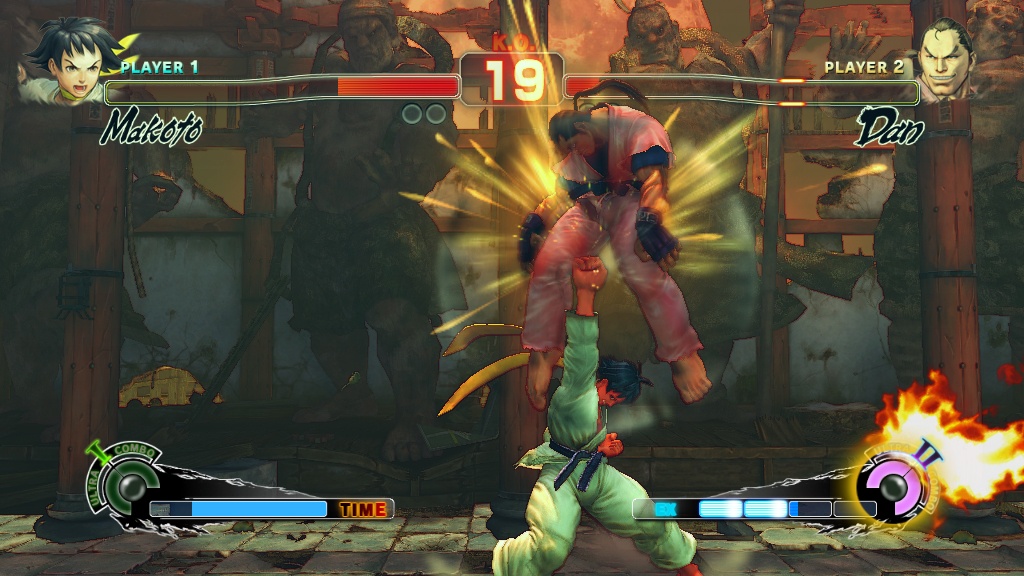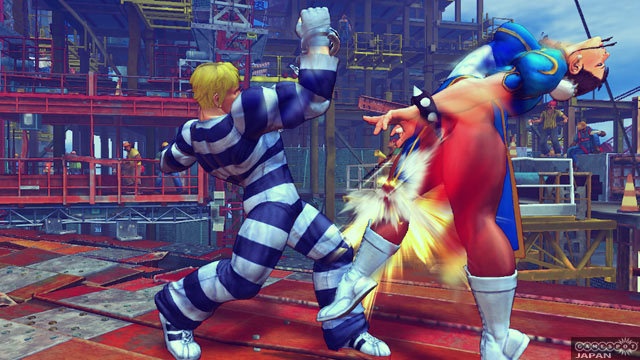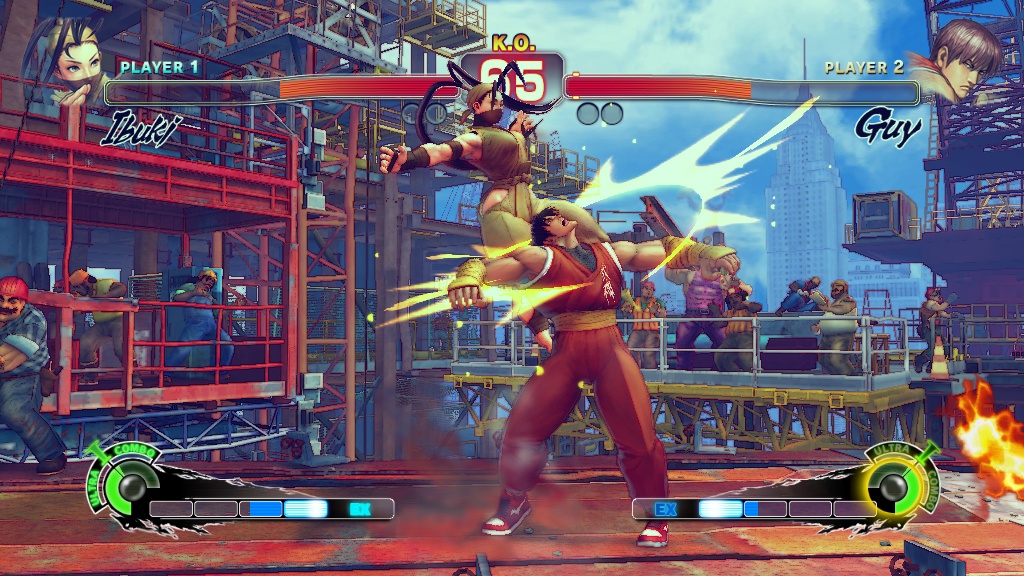In a world where downloadable content keeps games fresh long after their shine has started to fade, fighter fans may perceive the retail release of Super Street Fighter IV as a way of double-dipping into the pockets of series devotees twice in consecutive years. But that's not the case here. While the game expands on the solid base established by its precursor, Street Fighter IV, brawlers who dismiss this as merely a lick of paint and a roster update will do themselves a major disservice by passing on its excellent features and gameplay.
Some of the changes, such as the introduction of a second user-selectable ultra combo per character, new online battle modes, and fresh animated cinematics that bookend each storyline, are obvious, but plenty of work has also been done under the hood, away from prying eyes. Each character has been rebalanced to maintain a level playing field; for example, Sagat's Tiger Shot damage has received a minor reduction, while Ryu's fierce Shoryuken now lands two hits instead of one. For a game as ferociously contested online and offline as Street Fighter IV, these fine adjustments are just as important as introducing new fighters to the already well-populated roster.
Super Street Fighter IV adds 10 new playable characters: eight from previous Super Street Fighter, Alpha, and Street Fighter III games, and two brand-new ones. This brings the total roster up to 35 playable characters. The game's complete character roster--which is now available in its entirety from the outset and no longer requires multiple completions of Arcade mode in order to be unlocked--includes the 12 classic world warriors: Ryu, Ken, Chun-Li, Blanka, E. Honda, Zangief, Guile, Dhalsim, Balrog, Vega, Sagat, and M. Bison. All of the Street Fighter IV characters return: Cammy, Fei Long, Sakura, Dan, Rose, Gen, Abel, Crimson Viper, El Fuerte, Rufus, Gouken, Akuma, and Seth. New additions to the lineup are ninja schoolgirl Ibuki; young martial arts entrepreneur Makoto; Muay Thai kickboxer Adon; heavy-hitting Native American T. Hawk; Final Fight characters Guy and Cody; beat-crazed dancer Dee Jay; and gentlemanly pugilist Dudley.
Turkish oil wrestler Hakan and taekwondo Shadaloo agent Juri also make their debut. These two handle very differently from each other. While the comical appearance of the bright red Hakan and his body-oil-bathing routine are a bit strange, it does give him a competitive advantage; he uses heavy hits and slides in tandem with his grapple abilities to send opponents crashing into walls or looping in orbit around him like a hula hoop. By contrast, Juri's speed makes her nimble and deadly, perfectly suited to chaining together midair combo kicks, while her twirling EX Senpusha provides wide-reaching antiair defence.
Whether this is your first foray into the series or you're a seasoned vet, there is plenty of help available to get you up to speed with the characters and their abilities in Training and Challenge modes. Training is a free spar area to practice your moves with an AI-controlled opponent, while Challenge walks you through 24 must-know attacks and combos per character. While last year's game forced you to complete a challenge before being allowed to move on, accomplished and impatient players can now work their way through sequentially or skip the basics to tackle more difficult tests. The Survival and Time Attack modes have unfortunately been removed, but they've been replaced by the fun and nostalgic car and barrel destruction bonus stages, which can be played in isolation or woven into Arcade mode.
The game's story loosely holds your hand as it guides you through the fighting tournament the characters are taking part in. The attractive anime-style cutscenes in SFIV have been refreshed and give you another glimpse behind the gloves at the usually ridiculous motivations of the combatants. In true Street Fighter style, cutscenes ask as many questions as they answer, and though the characters' relationships with one another carry on from previous games in the series, first-timers and returning fans should have no trouble following along as the shallow story unfolds and steers you through the short Arcade mode.

All of the gameplay mechanics introduced in SFIV (such as focus attacks and rival matches) make return appearances, and you can now choose one of two ultra combos per fighter. This grants the choice between a ranged attack or close quarters combo to suit your play style. The ultras are listed only by name, and while they're easy to distinguish for all of the returning characters who were in SFIV (since all the new combos are marked in purple as Ultra II), expect some experimentation to work out which one you want to use for less frequently played characters.
A handful of new environments have been added to the mix and give you the chance to exchange your flurry of punches and kicks in a busy marketplace, atop a Metro City skyscraper construction site, and beside a river in an African landscape during a solar eclipse. They're varied and vibrant, and subtle touches, such as approaching hippopotamuses, cheering crowds, and clay vases that topple and smash as you pummel your opponent, give each locale a lively feel.
Online play has received the biggest improvement in Super Street Fighter IV. The game supports ranked match play, team battles (two vs. two, three vs. three, and four vs. four), and Endless Battle mode. Team battles are one-on-one round-robin matches, with the loser eliminated until a team is crowned victorious. Endless Battle supports a lobby of up to eight players and sees the winner staying on, with the next person in the queue taking on the defending champ. Voice chat during matches gives players on the bench the chance to yell encouragement or talk smack as they watch two players go head-to-head onscreen. It's the online equivalent of crowding around an arcade machine and is exceptional fun with strangers or a bunch of friends.

As it stands, the game doesn't support a dedicated tournament mode for online competitive play, but Capcom has confirmed the release of a free patch due in mid June this year which will add the feature. It's a disappointing omission given the comprehensive revamp of the online play in Super Street Fighter IV, but there's more than enough friendly and ranked content here to keep you throwing fireballs for a long time.
The video replay system has also received an overhaul in SSFIV and now automatically records all of your online matches. A dedicated video replay channel lets you view, rename, and rate your clips, save the keepers, and broadcast them instantly to a lobby of friends. Like in Training mode, players who are watching can toggle a display of player button input for one or both fighters, as well as enable a stats box overlay which shows how much damage each character is doing onscreen. Unfortunately, while the feature is undoubtedly a step up from the replay rating system in SFIV, which let accomplished players share their highlight reels, the tool is limited. You can skip between rounds and go into slow-mo mode (which simply halves the frame rate), but there's no way to pause or incrementally rewind the action. As a result, if you're trying to study a better player's replay, you need to rewatch an entire round and can't view just a snippet.
Options disappear further when you're sharing saved replay with friends, because you have to replay the video from the start of the match. Online is segmented into playing and watching, which makes sharing a little clunky. Want to relive an epic comeback or laugh at something amusing that happened in a game you just played? To do this, you need to drop your group, head to the Replay Channel, select your file, save it, rate it, and then invite the group back to a viewing lobby to screen the replay. A save option at the end of a match to move the replay from your capture to your keep pile would have made this process much simpler. Likewise, while the online leaderboard is easy to use and allows for comprehensive stat tracking of both your own and your friends' stats across the network, there's very little video replay integration. There's no way to specifically select replays uploaded by the top players on the charts; instead, you need to view the stat card of each newly uploaded match to determine if the points are high enough to warrant watching it.

As was the case with Street Fighter IV (and indeed online games in general), your Internet connection will determine the quality of your match. The signal strength icon usually gives a good indication of your online performance, and over a smooth connection the game plays like a local Versus match. Profile icons, titles, taunts, and new costume unlocks are rewarded at a steady pace and give you a chance to personalise your online fighter persona. Fans who have saved-game data from SFIV will also receive two bonus unlockable character shader effects available as costumes. It's a nice touch to reward players who upgrade from last year's game, but neither effect is particularly attractive, and they're purely cosmetic.
Super Street Fighter IV stands tall on the broad shoulders of its predecessor. Its large and diverse character roster, balance tweaks, and comprehensive online play reaffirm its place as one of the best fighters this generation, and it's a worthy upgrade even if you own last year's version. The results are improvements in every aspect of the game, making this a must-have for series fans and Internet brawlers.



